The English language is a little crazy.
I mean, just read these words: through, tough, though, thought. Same spelling pattern, four different sounds! ?
But. As weird as our language can be, it’s also predictable and consistent in many ways. In fact, did you know that there are only 6 different types of syllables in English words?
Yup, only 6! (Or 7….but I’ll get to that later.) My point is that there REALLY AREN’T THAT MANY!
Why do the syllable types matter to us, as primary teachers? Because it’s essential that our students understand how English sound and spelling patterns work, and syllables are a big part of that.
Plus, knowing the 6 syllable types….
- Helps kids divide words into syllables to decode them or write them
- Helps kids predict the sound a vowel makes
- Makes it much easier to break up multisyllabic words
In this post (which is part of my blog series about teaching phonics), I’ll explain what the six syllable types are and when you might teach them to your students.
This post is relevant for first grade and up!
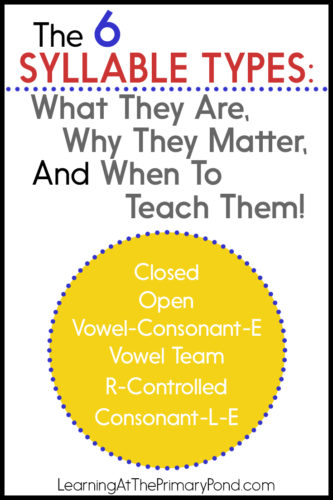
Okay, hang on. Before we get into the syllable types, let me define the word “syllable” for you:
A syllable is a unit of pronunciation that has one vowel sound.
Words can be made up of one syllable (i.e. chair) or several syllables (i.e. rhi/noc/er/os).
Syllable Type #1: Closed Syllable
What it is: A closed syllable is a syllable that ends with a consonant. The vowel has a short sound.
Word examples:
- hat (ends with a consonant, t, and has a short a sound)
- pigpen (this word has two closed syllables, “pig” and “pen,” both with short vowels -> pig/pen)
When to teach it: I usually teach this toward the beginning of first grade. Students should have lots of experience with CVC words. You can introduce 2-syllable words with 2 closed syllables (like “sunset” or “bathtub”) and explain what a closed syllable is. (By the way, in the “bathtub example, the division is bath/tub. Even though the first syllable technically ends with t AND h, they’re a digraph and therefore make one consonant sound, /th/.)
Syllable Type #2: Open Syllable
What it is: An open syllable has one vowel and is NOT “closed in” by a consonant. The vowel is “free to shout its name” (it’s a long vowel).
Word examples:
- me (no consonant at the end; the vowel is long and “says its name”)
- robot (the first syllable is “ro” and is open; the second syllable is closed -> ro/bot)
When to teach it: It works well if you teach the concept of an open syllable along with or shortly after teaching closed syllables. Again, the beginning of first grade is ideal for this – but you can also cover this concept at the end of Kindergarten if you’re introducing long vowel sounds. Words like “we” and “me” are great examples to use with Kinders, since they probably already know them by sight.
Syllable Type #3: Silent / Magic / Sneaky E / VCE
What it is: Whatever you wanna call it, the VCE (vowel-consonant-e) syllable type has a silent e at the end and a long vowel sound!
Word examples:
- bike (the silent e makes the i “say its name” – aka gives it a long vowel sound)
- mistake (the first syllable is “mis” and is closed; the second syllable is VCE -> mis/take)
When to teach it: This is a good concept to address during first grade, after students know their short and long vowel sounds. They should be familiar with the concepts of open and closed syllables. When you teach this syllable type, you can have students practice changing closed syllables to VCE syllables (i.e. taking “rid” and turning into “ride”).
Syllable Type #4: Vowel Team Syllable
What it is: A vowel team syllable usually contains two vowels that come together to make one long vowel sound. I also call patterns like “igh” vowel teams, so Some people divide up this syllable type into vowel digraphs and vowel diphthongs for a total of 7 syllable types.
Word examples:
- steam (the vowel team is the e and the a coming together to make the long e sound)
- soapbox (the first syllable is “soap” and has the vowel team “oa;” the second syllable is closed)
When to teach it: I usually teach this in first grade – after students are very comfortable with open and closed syllables, as well as silent e. I always have to review this in second grade, too.
Syllable Type #5: R-Controlled Syllable
What it is: In an r-controlled syllable, the letter “r” follows a vowel. The vowel doesn’t make a short OR long sound – rather, it’s “controlled” or “influenced” by the r and makes a different sound altogether.
Word examples:
- star (the a is controlled by the r)
- lobster (the first syllable is “lob,” a closed syllable, and the second syllable is “ster,” an r-controlled syllable -> lob/ster)
When to teach it: I teach this in first grade. I feel like it’s a toss-up between r-controlled syllables and vowel team syllables – either concept can be taught after kids learn open syllables, closed syllables, and silent e. I definitely review this concept in 2nd grade. And there are some more complex r-influenced spelling patterns that can be covered in later grades.
Syllable Type #6: Consonant-L-E Syllable
What it is: In a CLE syllable, a consonant + the letters “l” and “e” come at the end of the syllable.
Word examples:
- table (the first syllable is “ta,” an open syllable, and the second syllable is “ble,” a CLE syllable)
- example (ex/am/ple – the first two syllables are both closed, and the last syllable, “ple,” is a CLE syllable)
When to teach it: This is usually the last syllable type that I teach, and we typically address it in second grade.
Conclusion
If you didn’t know about the 6 syllable types until you read this post, you’re not alone!! I didn’t learn about this in my undergraduate education program, nor in my reading specialist master’s program! I learned this stuff after becoming a teacher and even after becoming a reading specialist – but boy, it sure has made teaching phonics easier!
If you’re looking for more support in teaching syllable types to your students, check out the resource below. This will walk you and your kids, step-by-step, through the entire process.
1st grade teachers will likely progress through the lessons slowly, spreading them out throughout the entire year. 2nd grade and up may be able to progress more quickly. But either way, you can match this mini-program to ANY phonics or reading program that you use!
If you don’t need lesson plans and syllable activities but you do want some practice activities for your students, check out my digital Boom cards.
These activities give your students practice with identifying syllable types AND dividing words up into syllables.
The games also include audio directions that explain the syllable types and division rules!

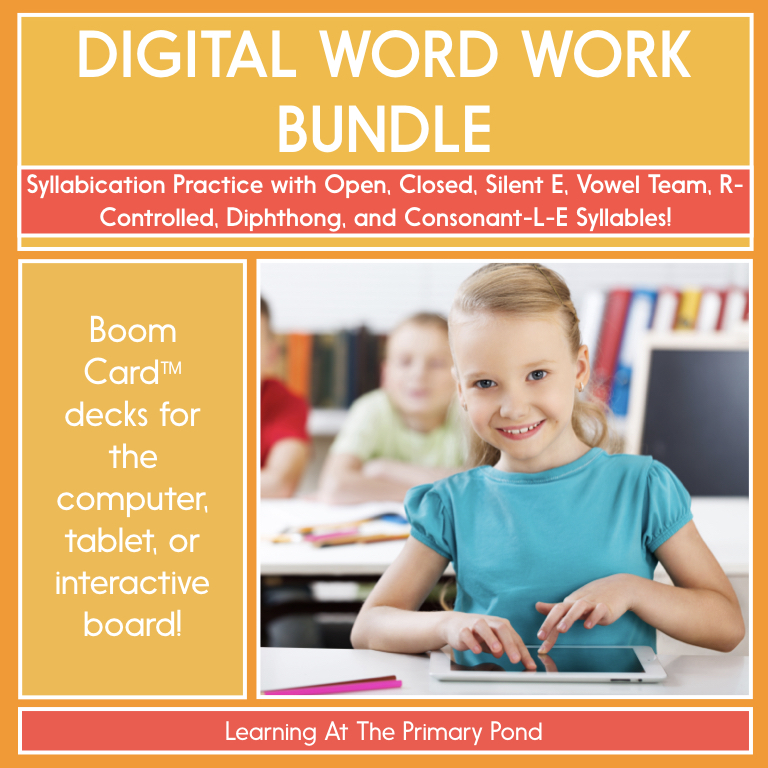
To learn more about how to actually divide words up into syllables, check out this post.
Happy teaching!

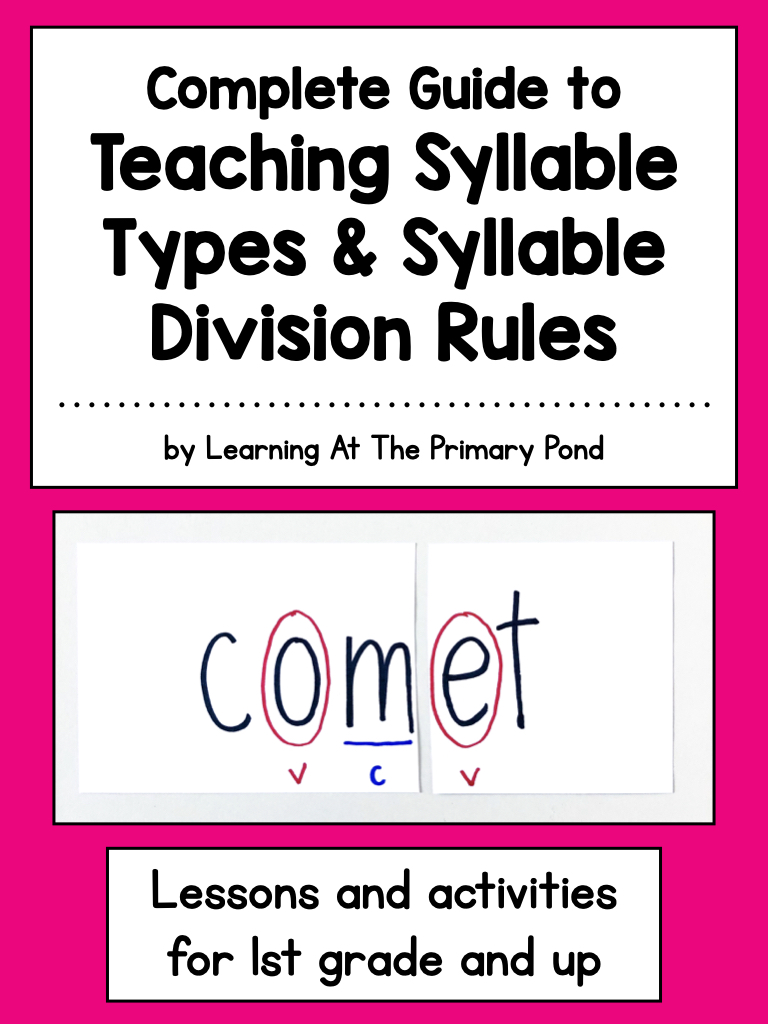


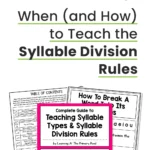
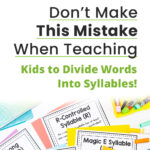

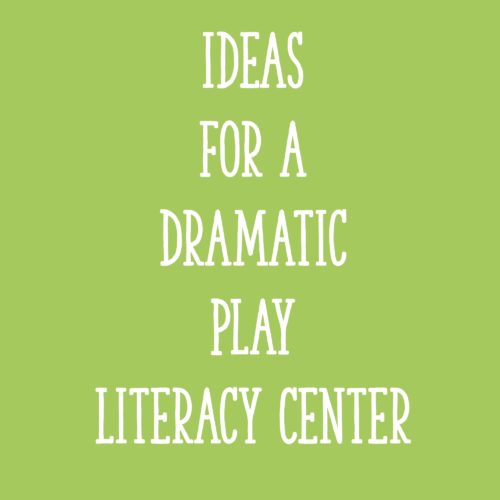







Thank you! My credential program was Whole Language and I did not learn any of this!
I’m so glad this was helpful, Leslie!!
Alison
WOW, how useful is this??? Many thanks for ypur post
Wow!! This is so helpful! And I am just learning about this now! This was a little hidden treasure for me, thank you so much for sharing:)
The reason diphthongs and Vowel teams are different syllable types: 1. With vowel teams you have the long vowel sound. It is a familiar sound that studnets know when say: vowel team, ai says a, cause the first one does the talking… etc. AND they are made of 2 vowels. 2. Dipthongs MOST of the time make a new sound that is NOT a long or short vowel and they are not a always a team of vowels. OW- not a team of vowels, so it should not be coded as a vowel team- says /ou/ in cow and /o/… Read more »
Makes perfect sense, esp. with the w! Thanks for sharing!
So helpful, Alison! I’ve been teaching for 20 years, and never had this spelled out for me somehow; thanks so much!
Hey Jenni! So glad it was helpful! Thanks for reading! 🙂
Alison
Is this in a cheat sheet anywhere? Thanks for the info!
Hey! I don’t have it in a cheat sheet, but there’s a “print” option at the bottom of the post where you can make it a PDF. 🙂
Alison
Do you have a printable chart for these with examples?? 🙂
Yes! I’ll be sharing that during my free webinar! 🙂 https://events.genndi.com/register/169105139238453707/369c365d3a?_ga=2.24247930.1173074121.1551910137-1784204218.1545942850
Alison
Thank you Allison!
This makes so much sense! Thanks for the clarity and examples!
You’re so welcome!! Glad this helped!!
All I can say is why didn’t they teach this the way you explain it? In a way that makes sense.This is truly remarkable! Thank you so much!
I’m so glad this helps!! 🙂
Alison
I’ve always wondered why the word “have” has a short vowel sound, but “behave” has a long a sound. Is this just an exception to the rule, or did spelling change over time with English while the pronunciation stayed the same (like with “gh” having different pronunciations depending on the word as you mentioned)?
Hey Lauren, such a good question!! I’m not sure myself, but I’m guessing that it has to do with pronunciations changing over time. The beginning of the Words Their Way book has some interesting stuff about the historical changes of vowels and other sounds.
Alison
awesome!
Awesome and Amazing
Thankyou!!! I just started as an aide in Special Ed…I need a crash course in this. You explain it all beautifully. I will be devouring your website. You had me at “I didn’t know this stuff either!!!”
And to think I have a journalism degree and worked as a copy editor!!!
Oh good!! I’m so glad this was helpful!! 🙂 Good luck with your new position!
Alison
Thank you for this lesson. I used this with my 6 year old today and it was so helpful.
Hi Eva! I am so glad that you found this helpful!😄
Awesome explanation! It seems that syllable patterns are rarely taught and I feel the main reason is many teachers are unaware of its importance.
Do you notice primary students having trouble remembering all the rules?
Thank you, Brandon! I do believe that teaching the syllable types is SUPER important! I’ve found that with primary students that the more they are exposed to the different syllable types, the better they are at remembering them. I make it a point to constantly review the rules (both in and out of context of explicit phonics instruction). For example, during a shared reading lesson, I may point out a word that I feel that students may struggle with and we would discuss how the syllable type helps us sound out the word.
Provided useful info for my adult Ed class. Thank You
That’s awesome! Thank you for sharing!
Thanks for the amazing short lesson.
You’re welcome!!
Thank you very much. I really appreciate your job.
Glad to hear!
I have seen other resources that distinguish 7 syllable types. The distinction they make is between vowel teams (ea, oa, etc.) and diphthongs (oy, ow, etc.): one vowel sound overpowers the other vs. both vowels create a new sound. Can you comment on this please?
Hey Heather! I don’t think there’s a right/wrong answer here. Diphthongs are just a type of vowel team!
Your website is amazing, congratulations. For the first time I was able to clearly understand the rules for separating syllables and pronouncing vowels correctly. As a Brazilian, I came to the conclusion that I needed to understand how children learn to pronounce words in order to correct my pronunciation in American English. The comments are also very interesting. It’s American educators giving their opinions, and for the first time I saw why words ending in “ve”, like love, are an exception to the “magic e” rule. Thanks to Smith for the explanation. I should have seen these rules before starting… Read more »
This is so wonderful to hear! And congrats to YOU for all that you’ve accomplished 🙂
A great post. I everything is clearly understood. Thank you so much
Absolutely!!